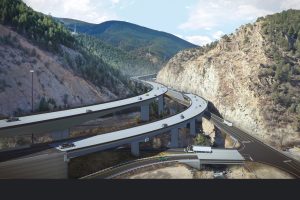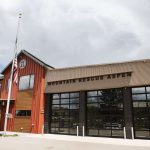With bridges starting to go up, drivers on I-70 will see ‘magnitude and size’ of $900 million Floyd Hill Project
Rock blasting and scaling operations will continue this winter with the goal of wrapping up by next spring or early summer, according to the Colorado Department of Transportation

Colorado Department of Transportation/Courtesy illustration
The Colorado Department of Transportation is moving mountains — literally — as part of a $900 million project to rebuild an 8-mile section of Interstate 70 to improve safety and travel time reliability.
Since October last year, crews working on the Floyd Hill Project have completed more than 135 rock blasts, removing more than 600,000 tons of material, an amount equal to the weight of 20 Statues of Liberty, according to the transportation department.
Now, work has begun to build new interstate bridges with gentler, safer curves through the widened canyon that is a main thoroughfare for those traveling between Denver and the mountains.
“Over the next four to six months, people are going to start to see where the new alignment is going to go,” said Matt Hogan, the project manager for Kraemer North America, the general contractor on the Floyd Hill Project. “They’re going to start to realize the magnitude and the size of the project, and hopefully really start to envision the future of what driving on this mountain corridor is going to be.”
A third lane, new bridges and smoother curves
Located between Evergreen and Idaho Springs from about Mile Points 241 to 248, the Floyd Hill Project began construction in July 2023 and is expected to be completed in 2029. CDOT has called Floyd Hill an “economic gateway for the state of Colorado and the nation.” It is both a central corridor for tourists heading up to the mountains as well as freight moving across the country.
One of the main goals of the project is to address a bottleneck that occurs on westbound I-70 at the top of Floyd Hill — where three lanes of traffic coming from Denver narrows to two lanes — on busy travel days, such as during ski traffic and holiday weekends. To reduce the bottleneck, CDOT plans to construct a new lane that will become a full-time, tolled Express Lane just west of Exit 247 at Homestead Road to Exit 241 at Idaho Springs.

“We see a lot of bottlenecked traffic and huge impacts on the weekends. It can discourage folks from going and exploring some of the mountain destinations, so it has an impact on the economy,” CDOT major projects communications manager Stacia Sellers said. “If we can keep traffic flowing, create that travel time reliability, you’re incentivizing people to come back up into the corridor.”
The project will also replace the existing bridges, which have become worn from heavy use, with new 115-foot-tall bridges, while changing the alignment of I-70 from the middle of Floyd Hill to the Veterans Memorial Tunnels.
CDOT Floyd Hill Project Director Kurt Kionka said the existing bridges have curves that are rated for 45 mph, even though the speed limit through that section of the road is 55 mph. (The speed limit is currently 45 mph through the work zone.) When completed, the new curves will be rated for 55 mph speeds.
Because I-70 is such a critical roadway, Kionka said that CDOT knew that it couldn’t shut down the road for days, weeks or months on end to complete the Floyd Hill Project. So the new bridges will be built over the existing bridges allowing traffic to continue moving other than for brief closures.
- Call the project information line at 720-994-2368 (CDOT)
- Text floydhill to 21000 to sign up for text alerts
- Email the project team at: cdot_floydhillproject@state.co.us
- Visit the project website at: codot.gov/projects/i70floydhill
“We are committed to keeping traffic moving through here. We know the importance of the I-70 corridor especially for the mountain towns,” Kionka said. “So, we’re doing a lot of our work behind barriers, and when we do need to close lanes of I-70 we do that at night.”
In addition to flattening curves and improving safety, the Floyd Hill Project will also create a new 2-mile section of frontage road along where there currently is no other roadway paralleling the interstate.
The new frontage road between the U.S. Highway 6 and Hidden Valley/Central City Parkway interchanges will improve resiliency and emergency response, Kionka explained. He said the frontage road will reduce the detour times for drivers as well as emergency vehicles, if I-70 is shut down due a crash or winter weather.
CDOT has also installed more than 2 miles of wildlife fencing as part of the Floyd Hill Project, which Kionka said is expected to reduce wildlife-vehicle collisions by more than 90%.
Floyd Hill Project to continue this winter
Rock scaling and blasting operations on the Floyd Hill Project will continue throughout the winter, requiring occasional traffic holds during off-peak travel times between 9 a.m. and 3 p.m. Mondays through Thursdays, according to CDOT. The goal is to wrap up the majority of the rock blasting by spring or summer of next year.
In early December, crews will also use multiple westbound I-70 overnight closures to build a temporary framework, which will support the future construction of the new bridge over live traffic.
CDOT expects westbound I-70 to be in its new alignment and open to traffic by the end of 2027, solving the bottleneck problem. Eastbound I-70 is expected to be in its new alignment and open by the end of 2028, with the entire project completed in 2029.

To date, 1,200 field employees have contributed more than 550,000 work hours to the project, according to CDOT. Kraemer North America has 162 subcontractors working on the project, 152 of which are Colorado-based businesses.
Noting that crews will be working throughout the winter and into next year, Hogan called on drivers to slow down and obey traffic laws in the work zone. He noted that it only takes an estimated 1.5 minutes longer to get through the construction zone driving 45 mph compared to 65 mph.
“Slow down for us please. The thing we ask for all the time is for people to slow down in this work zone. We’ve narrowed it up,” Hogan said. “There are men and women and parents and fathers and mothers working out here so the biggest request for us is to slow down in the work zone.”










